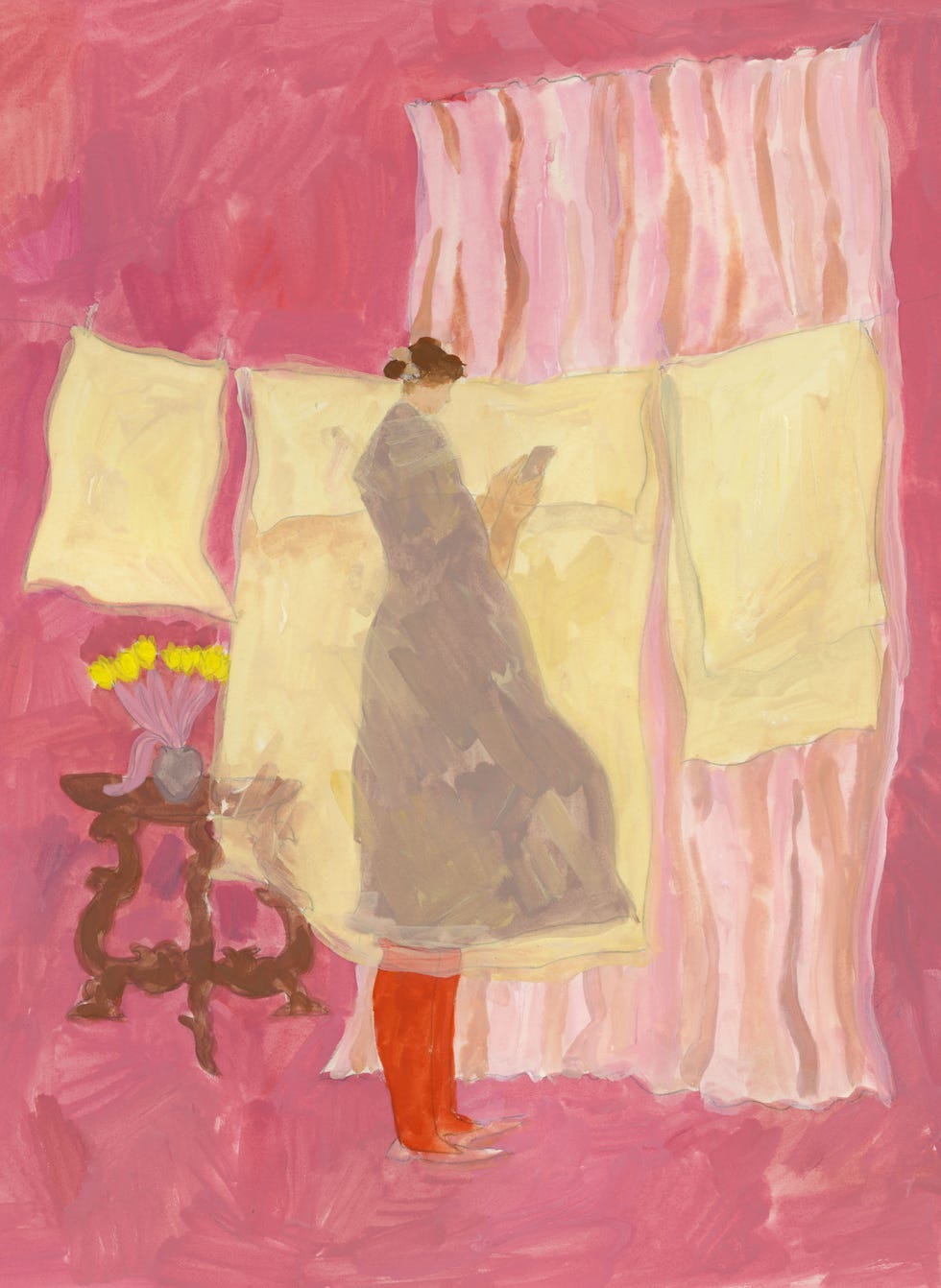The original post is located at www.elle.com
The tradwives log on to the private video group call from all across the country. One folds herself into a corner of her bathroom, claiming a few solitary moments. Another is barely visible, sitting outside a bedroom door in a darkened hallway, waiting out a child who refuses to sleep. They are spread across time zones—as one woman cooks dinner, her phone propped on the counter, earbuds in, multiple kids skittering through the kitchen, another nurses an infant who has just woken up from a nap. Others go on walks to get out of their husband’s earshot. Many hop on while running errands, using the confines of their car as a sanctuary. One woman’s video is always off; she says she is hiding in the laundry room.
Here there’s none of the purring servility typical of tradwife content. On live calls, and in video messages they send back and forth throughout the day using the chat app Marco Polo, the women admit feelings of overwhelm they’ve never told anyone else. Secrecy is paramount. Some husbands monitor their phone calls and text messages, so their wives delete their Marco Polo accounts or chats every day.
Many of the women do not have access to family bank accounts or their own credit history, nor do they have job experience, and some don’t even have driver’s licenses. They are supposed to be cheerful exemplars of women’s place inside the patriarchy: submissive wives, serving their husbands and raising children. Meals, cooked from scratch. Single-income budget, managed by thrift and coupons.
Except these women are done submitting; they are done being “perfect” wives. They want out.
Social media abounds with figures like Hannah Neeleman, the Juilliard-trained ballerina-turned-tradwife and mother of eight, who milks cows and sheep on her family’s 328-acre farm and sells protein powder to her over 10 million Instagram followers. There’s also platinum blonde Estee Williams, who wears vintage-style dresses and coos about notions of gender roles as old-fashioned as her frocks. And Kelly Havens Stickle, who showcases a rustic ideal as she irons, crafts with her children, and labors for God’s kingdom. Such content suggests that with the right approach—submission to one’s husband—and domestic skills, women can fulfill their “natural role” and enjoy a peaceful, happy family life.
What’s less visible behind the highly filtered portrayal of 1950s or prairie-style homesteading is the flip side of the movement—an increasingly vocal ecosystem on Instagram and TikTok of some former tradwives who became unhappy with their patriarchal lifestyle and left, and who now use their own experience as a model: They got out, and so can you.
Some simply share warnings, like a woman who goes by Jennie on TikTok, and posts about the dangers of financial dependence (“A man is not a plan”); she sees herself as “spilling the Mormon tea.” Others, like former tradwife and podcaster Enitza Templeton (@emergingmotherhood on TikTok), find themselves managing informal communities, an ad hoc arrangement of advice for financial and emotional independence. One of the more structured breakaway-tradwife communities was started by Margaret Bronson, a 34-year-old in Kansas City, Missouri, who is known online as the “Deconstruction Doula.” For five years, she has been helping tradwives find one another, dissect their beliefs, and claim an identity beyond wife, mother, and bread baker.
In the fall of 2022, Bronson started offering peer support to women who were ready to question their core beliefs. They meet via Zoom, in cohorts of 8 to 10 women, to share their hardships. Like a doula serving a laboring woman, Bronson says she reflects back what the women say they want and need, and gives them room to express pain as it comes.
The first time the women meet virtually, many come with prepared notes. The stories they have to share get deeply real, very fast. There was the young mother pushed to suicidal ideation—she just couldn’t keep joyfully performing submission. Another in the Pacific Northwest kept her miscarriages secret from her husband; such pain had no place in her aspirational life. “There’s this chain of women who have been through it, and know what’s going on, and can help,” says Haley, a 32-year-old woman from the Midwest who is part of one of Bronson’s cohorts. (Some women asked to keep their last names private.)
Haley says she was taught not to connect with other wives and mothers in this way. Church sermons warned that “gossip,” including sharing marital grievances, was a sin. Women should avoid even sitting with others who “talk bad about their husbands,” Haley says. “So I can’t even ask if anybody else is feeling this way, because then that’s gossiping, and I don’t want anybody to think I would ever say anything bad about my husband.” Instead, she was told to pray to make her marriage happier. Bronson’s group was the only place, she says, “where I could feel like it wasn’t just because I was a bad wife that I was unhappy.”
Bronson herself grew up attending a small Baptist church in a mid-Atlantic state, where women wore head coverings and floor-length dresses. “The pastor was extremely adamant that parents should have the legal right to stone their disobedient children,” she says. It’s weird for her to see tradwife content trending online now as if it’s something new. “Just about all the moms I knew growing up were tradwives,” Bronson says. They just didn’t call it that. It wasn’t a trend, just a reality.
She says the modern influencer model of tradwives is “so gross and so toxic.” But when she thinks about it, it’s just an updated version of her mother’s generation, who modeled their clothing and lifestyle aesthetic on the Duggar family, of TLC’s 19 Kids and Counting fame, and the influential minister Bill Gothard. Gothard, recently featured in the Prime Video documentary Shiny Happy People: Duggar Family Secrets, reached 2.5 million people through his seminars, books, and homeschool curriculum that taught a mix of oppressive, gendered obedience and life skills, like avoiding “eye traps”—long necklaces, plunging necklines, or skirts cut above mid-calf—that fixed men’s gaze on women’s bodies and could provoke lust. Gothard encouraged women to style their hair long and curly, in a way that pleased their husband or father.
“I could count Gothard as one of the starting points” for modern tradwives, “but there are some others,” says Kristin Kobes Du Mez, PhD, a historian specializing in gender, religion, and politics at Calvin University in Michigan. Women have been staying home to raise children for centuries, but increasingly among conservative Christians in the 1960s and ’70s, women’s roles became less a personal choice and more of a “political and religious statement.” The stay-at-home ideal corresponded with the rise of teachings from Gothard and others that were not just “anti-feminism, but more broadly an embrace on the Christian right of a theology of hierarchy of authority and submission,” Kobes Du Mez says. Obedience to God came to mean obedience to other figures in the church who held authority, she adds, which in broader evangelicalism could “have very clear gender implications.”
As Kobes Du Mez points out, evangelicalism is a movement that spans denominations—from moderate megachurches to more extreme congregations, from homeschool networks to folks who tuned in to listen to Focus on the Family—so how those teachings play out practically can be a grab bag. Some women in the ex-tradwives groups were raised as “stay-at-home daughters,” transferring in adulthood from the authority of their father to that of their husband, with no space for independent living or education in between. Some others had to keep the house clean or cook to their husband’s specifications, or face spankings from their husbands, as recommended by their pastors, Kobes Du Mez says. Still others, following more mainstream leaders, might have more freedom—but never the last word.
Bronson was primed for a patriarchal marriage. In an internet Lord of the Rings fan forum, she met the man she married at 19, a would-be Southern Baptist pastor. She’d planned to live in some ways as her mother had, but over the course of a decade of their marriage, she and her husband transformed spiritually. Her husband often came home from seminary, asking her opinions about theology. Together, they puzzled over why certain ideas in their stringent faith “give me the ick,” she says. “Our whole relationship is talking about ideas.”
Many of Bronson’s friends may not have had such freeing relationships. On Facebook, she saw old friends appearing to struggle, fading like “ghosts” after having four or five babies in five years. Maybe it was “survivor’s guilt,” Bronson says, but during the COVID lockdown in 2020, she desperately wanted to reconnect with her friends and offer help: “So I just started running my mouth, mostly on Instagram.”
Like her, many of the women Bronson works with have been, essentially, bred for the tradwife life. Joy Wiren grew up in a conservative church community like Bronson, and met her husband at a local Christian youth theater program. Wiren was 19 when they married, and says she thought she was supposed to be sexually available all the time, handle everything pertaining to the house and kids, and always “be in a good mood.” “I was like, ‘I don’t understand how I’m supposed to do this.’” She says she held herself to standards that her husband—who wasn’t raised in the same church—never expected her to meet.
One woman Wiren followed named Cassidy Jade (with 533,000 Instagram followers) had monetized her tradwife life, curating visually stunning clips: playing in creeks with her kids or baking homemade pies or serving Cowboy Colostrum (drinks supplemented with a cow’s first milk) on her homestead. Wiren thought, “She can do it. Why can’t I do it? Why can’t I figure out how to do it and make it beautiful?”
Author Jo Piazza immersed herself in the tradwife world before writing her thriller, Everyone Is Lying to You, out this July. She worries about impressionable, disconnected young women finding a sense of “faux community” in online tradwife circles. When you’re isolated, or you’re in the lonely postpartum period, tradwife influencers are there to sell you a godly cooking class, protein supplements, Biblical affirmation wallpaper for your iPhone—but above all, an ideal. “These highly aspirational and highly filtered images” are dangerous, Piazza says, because they “flatten the labor of women [and the] emotional reality of being completely dependent on a man.”
Wiren needed real community. Six months pregnant with her third child at age 23, she tried to do everything, but she couldn’t. She’d had secret thoughts of suicide for three years at that point, and one day was “visualizing going into the kitchen and slitting my wrists.” She was fighting the urge because she was pregnant, and her toddler was crying in her crib. “I kept thinking, ‘What if she got out of her crib and found me?’”
So she called her husband at work, who rushed home and had her get on the phone with her mother “and not stop talking until he was at the house.” That night they took her to the emergency room, then she was transferred for a 48-hour, voluntary inpatient psych assessment. But the medical team there suggested her depression might have been caused by her hormones. Although she was given pamphlets and encouraged to seek therapy, their faith-based, cost-sharing health care program did not cover it. The Christian counselor she did find was “very kind” but not helpful.
Her husband, desperate to understand his wife’s upbringing, discovered Bronson on Instagram. At first, after she joined one of Bronson’s groups, Wiren was nervous. She wouldn’t talk during the calls “unless someone told me it was my turn.” But when she did speak up, “I enjoyed being able to tell my whole story and have people believe me right away and agree,” she remembers.
Young moms need community, and when some women first find tradwife influencers, it can feel like a lifeline. Brittany, 35, from the Pacific Northwest, says about a year after she was married, her doctors found “a tumor, a massive tumor, like 11 pounds, and I felt like God was punishing me [for having taken birth control].” As a result, she says she stopped taking contraception and was soon pregnant with twins. After their birth, “I didn’t know it, but I had postpartum depression.” She says she was trying to “live this life that not even my husband wants…I’m trying to fit into this box.”
When the babies were six months old, Brittany discovered blogs like Keeper of the Home, precursors to tradwife social media accounts, including some by Christian homeschool influencers like Tsh Oxenreider and Jami Balmet. They had lovely pictures and seemed a “little bit rebellious.” Some wore pants, and others used birth control, and Brittany thought, “I can be this modern tradwife.” She followed their advice. “I was lonely, and every time I made a meal or used a sewing pattern or read a book these women recommended, it made me feel part of a community,” Brittany remembers. But by 2020, after her fourth child was born, she says her husband warned her, “you’re killing yourself trying to make this life.” That’s when she found Bronson and the other women.
And then these women, so adept at caring for their own families, started to take care of one another. A woman who asked me to call her Elizabeth describes how, before their split, she and her husband separated, but continued living together. But it wasn’t working. “My nervous system was so dysregulated whenever he was home,” she says.
A friend from Bronson’s cohort offered to let her stay in her home office each weekend. Another woman, also from the group, came to help her pack, and Wiren joined her to load the truck. Once she moved, Haley helped unload the truck and “brought me all this food,” Elizabeth says. Another support-group friend offered to put Elizabeth on her family phone plan. Others Venmoed her money. “I really would not have been able to do it without that support, and I did not have the majority of those people in my life four years ago,” Elizabeth says.
When another woman in the Southwest decided it was time to divorce her husband, three others from the group drove her to a coffee shop; one had to fly in for the visit. It was like an Oceans 11 heist-planning scene for independent adulting. They spent five hours going over a binder full of secretly gathered information—her own family bank statements, other financial paperwork she didn’t understand. The women talked her through how to get a driver’s license and how public school works. (Many of these women, homeschooled themselves, don’t know the basics, like when a semester starts or how long a school year is.) They took her to the courthouse to pick up the paperwork to file for divorce. They convinced her that she should hire a lawyer, if only to protect her kids.
If Bronson is a doula for ex-tradwives, Enitza Templeton is running triage. She goes live on TikTok most days of the week, and typically several hundred women join her there. Others send DMs or emails looking for support. “It’s usually five paragraphs of trauma…and then the last few sentences are, ‘I’m really unhappy and I don’t know how to leave,’” Templeton says. “I don’t know their situation and I can’t save them, but I can give them hope and help them form a plan.”
That plan—for women fully financially dependent on their husbands—usually entails finding work. Templeton advises women without a work history to find something they can jump into quickly. She herself has four children, one of whom has Down syndrome and a congenital heart condition. When she was contemplating leaving her marriage, she learned that in Colorado, where she lives, family caregivers can become certified nurse assistants with additional training. The certification gave her the financial independence to leave her husband. One woman Templeton advised in the South started a home-cleaning business; another makes custom cakes. A third found a grant to pay for a coding boot camp. “Now she’s a coder and makes more money than her ex-husband and pays him child support,” Templeton adds.
The goal is self-actualization, whether or not their husbands come along for the journey. As women come into their own, Bronson has seen some couples explore a “delayed adolescent” period and others divorce as friends. Other men see their wives self-actualizing and perceive themselves losing power. Some women’s husbands have pulled guns on them when they said they wanted to leave. “We have one woman right now who’s spent the last three months staying with different women in our community because her husband has a plan to kill her,” Bronson says. But some men find their own liberation within their marriages, dropping the patriarch act. Elizabeth told me about one woman’s husband who now sports a floral trucker hat. He has learned he likes hiking and identifying plants. Bronson mentions another “very manly” man who has taken up gardening to make his own simple syrups for cocktails and the bourbon he ages.
To date, 144 women have been part of Bronson’s groups. Her work with them is ongoing. She says a big part of her continued relationship with the women she assists is “identifying the developmental milestones…the women were not allowed to go through.” They learn how to be their own person. Contrary to social media tradwives who dress for the male gaze, members of Bronson’s cohorts frequently make their first attempts at self-expression and autonomy by reclaiming their personal style. They start showing up to video chats with undercuts, pixie cuts, even mullets. Some dye their hair pink. Others have gotten tattoos or nose piercings. Their fashion evolves. Maybe they start wearing pants or swap conservative dresses for jumpsuits with a cute cardigan.
Occasionally, Bronson organizes three-day retreats. For most women who attend, the time of nervousness and need to keep the conversations secret has passed. They do crafts, laze in hot tubs, go on hikes, and laugh and cry together over what they’ve lived through and what their lives can now become. Bronson makes sure those headed onto retreats know one another, holding six getting-to-know-you calls in advance. But many don’t need the formal introduction, because they’ve come up in a cohort together and know one another intimately. “It’s my favorite thing to see people meet their best friends in real life for the first time,” Bronson says.
Whether at retreats or in quiet video chats whispered in the car, these women open doors for one another and breach the inherent solitude of life as a tradwife. There’s a joke that they shuffle the same $20 back and forth across Venmo in order to take care of one another. A 31-year-old former tradwife from the Southwest told me that during one of the hardest times in her life—when her daughter was in treatment for pediatric cancer—the women in her group became her family. “Even though I didn’t know what was going to happen the rest of that day,” she says, “I always knew that I was going to have a hot coffee.”
















